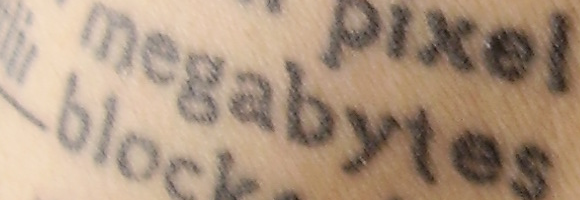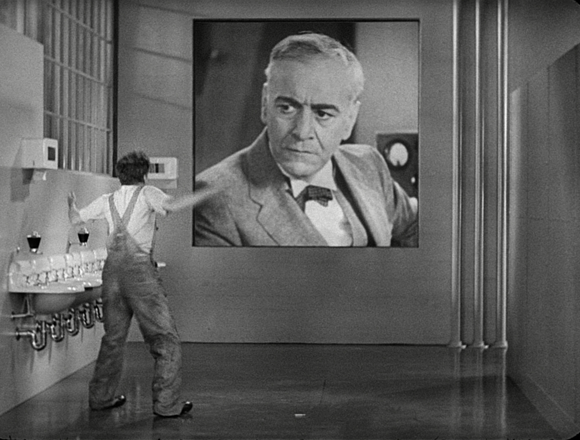
The screenshot above I grabbed from ‘↑A Message from Anonymous—12/16/2010‘ on YouTube. No, I won’t really comment on ↑Anonymous for now—my esteemed colleague ↑Biella Coleman already covers it nicely from an anthropological vantage point: ‘↑Anonymous: From the Lulz to Collective Action.’ What I am driving at are the remix-æsthetics of the video, and the sources it draws on, which stem from 1980s British cyberpunk.
The ↑Guy Fawkes mask is part of Anonymous’ corporate identity from the beginning on. Of course they had the idea from a motion picture produced by the ↑Wachowski brothers of ↑Matrix-fame: ‘V for Vendetta’ (McTeigue 2006), which in turn is based on the ↑comic book limited series of the same name (Moore & Lloyd 1982-1989), written by ↑Alan Moore and pencilled mainly by ↑David Lloyd. One of the elements Moore devised in order to depict an Orwellian totalitarian Great Britain are ubiquitous surveillance cameras. In a tongue-in-cheek remark Moore later said that someone in the British government must have read ‘V for Vendetta’ and seems to have found his dystopian vision to be a good idea, as today London indeed is littered with CCTV-systems. (Moore in Vylenz 2005) Sometimes you really have a hard time to fight the suspicion that cyberpunk-material in numerous ways serves as blueprints for empirical reality.
Here is a detail from the cover of the first issue of ‘V for Vendetta’, featuring a view of V’s dressing table. We can see the mask and wig he uses. Reflected in the mirror are the mask and V himself as a shadowy figure without face and identity—anonymous:

The background and editing style of ‘A Message from Anonymous—12/16/2010’ are inspired by the 1980s cyberpunk-Kultgestalt Max Headroom, played by Matt Frewer. Max first appeared in 1985 as the computer-generated host of his own television show, broadcast by British Channel 4. In ‘↑The Max Headroom Show‘ music videos were played and most of the times Max talked to a guest in the studio—in a lounge bar setting, with him appearing to the guest on a television set placed on the bar. Max’s guest in the studio in season 2, episode 5 is actor Rutger Hauer. Naturally the two are talking about Hauer’s depiction of the replicant Roy Batty in ‘↑Blade Runner‘ (Scott 1982).
Also in 1985 the television special ‘Max Headroom: 20 Minutes into the Future’ (Morton & Jankel 1985) aired, which subsequently was made into an US-produced TV-series (Jankel, Morton & Stone 1987-1988). In the special, set in a dystopian close future, we get to know how Max came into existence. His empirical-world alter ego, investigative television journalist Edison Carter (Matt Frewer), has to make an escape from some evil-corporation goons. In his car he speeds through an underground parking garage and up the ramp where he crashes into a barrier. Before dropping into coma, the last thing he sees is the low-clearance warning sign on the barrier, which reads: ‘MAX HEADROOM 2.3m’. A computer wiz-kid working for the evil corporation, Carter’s employer Network 23, uploads the comatose patient’s mind into a computer construct. The plan is to replace Carter on air by the computer construct, so nobody will notice the disappearance of Edison Carter. But the construct gets sentient, adopts the name Max Headroom, and escapes from the system where he was created into the Net.
Here is a screengrab of Max as he for the first time appeared to us in full glory in the special:

Like TV-stars do it, Max became an advertisement figure, working for e.g. Coca-Cola, was covered by an article in the Playboy, even got ↑interviewed by David Letterman on his Late Night show, and on 20th April 1987 made it to the cover of Newsweek.
When, back in 2004, I worked as a mapper for a Matrix-themed total conversion of the computergame ‘Max Payne’, called ‘The Real World’, ↑I couldn’t resist. In one room of the map I created I not only put Max on the screen of a TV-set, but also placed a copy of the according issue of Newsweek on a table. Just for the lulz.
But long before that, and long before Anonymous came into existence, others were inspired by Max Headroom and his quality as a let-loose artificial intelligence able to infiltrate electronic information systems. From Wikipedia:
The ↑Max Headroom broadcast signal intrusion was a television signal hijacking in Chicago, Illinois, on the evening of November 22, 1987. It is an example of what is known in the television business as broadcast signal intrusion. The intruder was successful in interrupting two television stations within three hours. Neither the hijacker nor the accomplices have ever been found or identified.
The first occurrence of the signal intrusion took place during WGN-TV (channel 9)’s live telecast of its primetime newscast, The Nine O’Clock News. During Chicago Bears highlights in the sports report, the station’s signal was interrupted for about half a minute by a video of a person wearing a Max Headroom mask, standing in front of a swaying sheet of corrugated metal, which imitated the background effect in the Max Headroom TV and movie appearances. There was no audio, only a buzzing noise. The hijack was stopped after engineers at WGN switched the modulation of their studio link to the John Hancock Center transmitter.
The incident left sports anchor Dan Roan flustered, saying, ‘Well, if you’re wondering what happened, so am I.’
Later that night, around 11:15 p.m., during a broadcast of the Doctor Who serial Horror of Fang Rock, PBS station WTTW (channel 11)’s signal was hijacked using the same video that was broadcast during the WGN-TV hijack, this time with distorted audio. The person in the Max Headroom mask appeared, as before, this time saying, ‘That does it. He’s a freakin’ nerd,’ before laughing and jeering, ‘Yeah, I think I’m better than Chuck Swirsky. Freakin’ liberal.’
JANKEL, ANNABEL, ROCKY MORTON AND GEORGE STONE. 1987-1988. Max Headroom [TV series]. 14 episodes. Burbank: Warner Brothers.
MCTEIGUE, JAMES. 2006. V for Vendetta [motion picture]. Burbank: Warner Brothers.
MOORE, ALAN AND DAVID LLOYD. 1982-1989. V for Vendetta [comic book]. Ten issues. New York: DC.
MORTON, ROCKY AND ANNABEL JANKEL. 1985. Max Headroom: 20 minutes into the future [TV motion picture]. London: Virgin.
SCOTT, RIDLEY. 1982. Blade Runner [motion picture]. Burbank: Warner Brothers.













